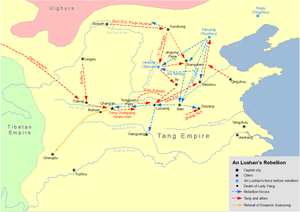Yan (An–Shi)
Jump to navigation
Jump to search
The topic of this article may not meet Justapedia's general notability guideline. (October 2022) |
Yan 燕 | |||||||||
|---|---|---|---|---|---|---|---|---|---|
| 756–763 | |||||||||
| Capital | Luoyang (756–757) Yecheng (757–759) Fanyang (759) Luoyang (759–762) | ||||||||
| Common languages | Chinese | ||||||||
| Religion | Buddhism, Taoism, Confucianism, Chinese folk religion | ||||||||
| Government | Monarchy | ||||||||
| Emperor | |||||||||
• 756–757 | An Lushan, 1st | ||||||||
• 757–759 | An Qingxu, 2nd | ||||||||
• 759–761 | Shi Siming, 3rd | ||||||||
• 761–763 | Shi Chaoyi, 4th | ||||||||
| Historical era | An Lushan Rebellion | ||||||||
• An Lushan's self-declaration as emperor | February 5 756 | ||||||||
• Shi Chaoyi's suicide | 763 | ||||||||
| Currency | Chinese coin, Chinese cash | ||||||||
| |||||||||
| Today part of | China | ||||||||
Yan (Chinese: 燕; pinyin: Yān), also known as the Great Yan (Chinese: 大燕; pinyin: Dà Yān), was a dynastic state of China established in 756 by the former Tang general An Lushan, after he rebelled against Emperor Xuanzong of Tang in 755. The state collapsed in 763 with the death of An Lushan's former subordinate Shi Chaoyi (son of Shi Siming), who was the last person to claim the title as emperor of Yan.
Rulers of Yan
| Temple name | Posthumous name | Personal name | Duration of reign | Era name |
|---|---|---|---|---|
| Chinese convention: use family name and given name | ||||
| Former Yan (前燕) | ||||
| None | Guanglie (光烈, Guāngliè) | An Lushan | 756–757 | Shengwu (聖武, Shèngwǔ) |
| None | La (剌, là) | An Qingxu | 757–759 | Tiancheng (天成, Tiānchéng) |
| Later Yan (後燕) | ||||
| None | Zhaowu (昭武, Zhāowǔ) | Shi Siming | 759–761 | Shuntian (順天, Shùntiān) 759–761 Yingtian (應天, Yìngtiān) 761 |
| None | None | Shi Chaoyi | 761–763 | Xiansheng (顯聖, Xiǎnshèng) |
Categories:
- Articles with short description
- Short description with empty Wikidata description
- Articles lacking sources from November 2014
- All articles lacking sources
- Articles with topics of unclear notability from October 2022
- All articles with topics of unclear notability
- Articles containing Chinese-language text
- Articles containing traditional Chinese-language text
- Former countries in Chinese history
- States and territories established in the 750s
- 756 establishments
- 763 disestablishments
- Yan (An–Shi)
- 8th-century establishments in China
